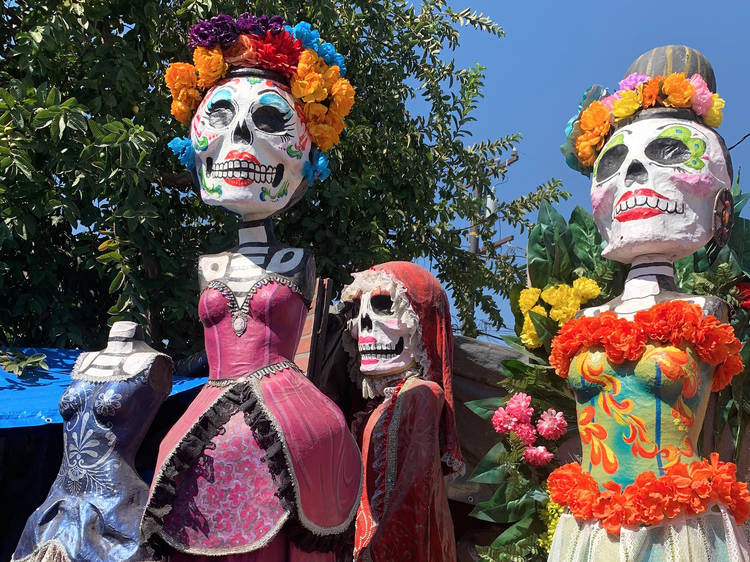
Día de los Muertos: Discovering Mexico’s Yearly Day of the Dead Customs and Festivities

**Delving into the History and Customs of Día de los Muertos: Mexico’s Celebrated Day of the Dead Festivity**
Death has always posed a significant enigma for people, and while numerous cultures respond to it with sorrow, apprehension, and gravity, Mexico presents a distinct and lively counterpoint through its observance of **Día de los Muertos** (Day of the Dead). This deeply entrenched Mexican festival joyfully honors those who have passed away, inviting their spirits to reunite with the living for a brief period, as their existence is celebrated rather than mourned.
The customs and traditions tied to the Day of the Dead have transformed over centuries, merging pre-Columbian and Spanish influences into a festival that is both culturally relevant and intimately personal. In this piece, we explore the rich customs, historical foundations, and present-day manifestations of Día de los Muertos to comprehend why it continues to be such a potent and globally acknowledged commemoration today.
## What is Día de los Muertos?
**Día de los Muertos**, typically observed from *October 31 to November 2*, transcends a mere Mexican tribute to those who have died—it encapsulates a cultural affirmation of life, death, and everything that lies in between. Although frequently misinterpreted as “Mexican Halloween” due to the timing, Día de los Muertos is a revered occasion rooted in memory and honor, devoid of the pranks or mischief associated with Halloween festivities.
Each of the three days of the festival possesses a distinct significance:
– **October 31** is designated as a day of preparation.
– **November 1**, recognized as **Día de los Inocentes** (Day of the Innocents) or **Día de los Angelitos** (Day of the Little Angels), focuses on commemorating the spirits of deceased children.
– **November 2**—known as **Día de los Muertos** or **Día de los Difuntos**—is devoted to the souls of adults who have departed.
Throughout these days, families gather to create personal altars called **ofrendas**, where they present offerings to assist the spirits in their journey from the afterlife back to the living world.
## History of Día de los Muertos
### Pre-Columbian Origins
The custom of joyfully commemorating those who have died dates back to the era of the **Aztec Empire** (1300-1521 CE). The Aztecs and other *Mesoamerican* cultures viewed death not with sadness but with celebration, considering grief as a disservice to their ancestors. Instead, they held the belief that the spirits would return to visit the living. A notable figure in these early customs was **Mictēcacihuātl**, the underworld goddess, often referred to as “The Lady of the Dead.” Celebrations during this period were dedicated to Mictēcacihuātl and welcomed spirits back into the living realm for the entire month.
These early festivities occurred in **August**, but after the Spanish Conquest in the 16th century, the celebration’s schedule was shifted to align with **Allhallowtide**, the Christian observance that includes **Halloween** (All Hallows’ Eve), **All Saints’ Day** (November 1), and **All Souls’ Day** (November 2). This fusion of indigenous and Catholic customs established the contemporary iteration of the Day of the Dead we recognize today.
### Catholic Contributions
Following colonization, **Catholicism** permeated Mexico, imparting new religious practices and blended elements to indigenous celebrations. Catholic **Allhallowtide**, which arose in Europe to venerate saints and souls in purgatory, became intertwined with the pre-Columbian rituals honoring spirits. Gradually, figures like Mictēcacihuātl merged with new symbols. Among these is **La Calavera Catrina**, a skeletal figure that has become an emblematic and secular representation of the holiday, showcasing a blend of indigenous and Catholic influences.
The renowned Mexican artist **José Guadalupe Posada** played a crucial role in popularizing **La Catrina** in the 20th century, incorporating a skeletal female figure in his art to satirize Mexicans aspiring to European aristocracy. Today, Catrina stands as a central symbol of the Día de los Muertos celebrations.
## Components of the Festivity
### The **Ofrenda**: Core to Día de los Muertos
A particularly moving tradition of the festival is the creation of **ofrendas** (altars), intended to welcome souls back to the realm of the living. Meticulously arranged and adorned, these altars showcase offerings that consist of symbolic items meaningful to both the living and the deceased.
1. **Decorations**
– Vivid colors define the decorations of the Day of the Dead, featuring various anthropomorphic depictions of *death*.
– **Papel Picado**: Brightly colored tissue